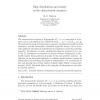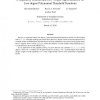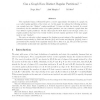101
click to vote
RSA
2011
14 years 7 months ago
2011
We prove that for fixed integer D and positive reals α and γ, there exists a constant C0 such that for all p satisfying p(n) ≥ C0/n, the random graph G(n, p) asymptotically a...
112
Voted
CPC
2007
15 years 18 days ago
2007
Abstract. Szemer´edi’s regularity lemma for graphs has proved to be a powerful tool with many subsequent applications. The objective of this paper is to extend the techniques de...
106
click to vote
COMBINATORICA
2006
15 years 20 days ago
2006
Let T be a fixed tournament on k vertices. Let D(n, T) denote the maximum number of orientations of an n-vertex graph that have no copy of T. We prove that D(n, T) = 2tk-1(n) for ...
91
Voted
CPC
2008
15 years 21 days ago
2008
In 1998 Luczak, R
95
Voted
APAL
2010
15 years 23 days ago
2010
The characteristic sequence of hypergraphs Pn : n < associated to a formula (x; y), introduced in [5], is defined by Pn(y1, . . . yn) = (x) in (x; yi). We continue the study o...
107
Voted
COCO
2010
Springer
15 years 4 months ago
2010
Springer
We give a “regularity lemma” for degree-d polynomial threshold functions (PTFs) over the Boolean cube {−1, 1}n . Roughly speaking, this result shows that every degree-d PTF ...
103
click to vote
COCOON
2007
Springer
15 years 6 months ago
2007
Springer
The regularity lemma of Szemer´edi gives a concise approximate description of a graph via a so called regular-partition of its vertex set. In this paper we address the following ...
109
click to vote
FOCS
2009
IEEE
15 years 7 months ago
2009
IEEE
— We present new combinatorial algorithms for Boolean matrix multiplication (BMM) and preprocessing a graph to answer independent set queries. We give the first asymptotic impro...



